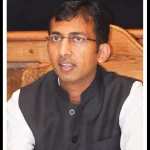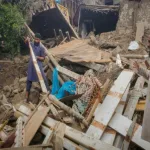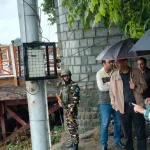Prime Minister, Narendra Modi inaugurated the historic rail connectivity corridor between Jammu and Srinagar on June 6 ushering in new prospects of security, development, investments, tourism and economy in the region. The all weather Vande Bharat train that has cut the travel time from Jammu to Srinagar to four and a half hours and the engineering marvel bridges over the Chenab and Anji Khad in Reasi mark a new era in the history of India’s northern territories.
Surprisingly it took really long for this connectivity to manifest. Chief Minister, Omar Abdullah on Thursday said it’s a landmark occasion and it was prolonged. “If I say that I have been waiting for this day for a long time, it won’t be an exaggeration. This project started when I was in school, maybe in class 7 or 8. Today, my children have also completed their education and are now working,” Abdullah said while talking to reporters at the Katra Railway station.
This could be true for many large infrastructure projects in Jammu and Kashmir which in addition to being the northernmost state of India is also a territorial civilizational corridor marked by many mountain passes and river valleys that connect three river basins: Amu Dariya, Indus and Gangetic basins to each other.
Its obvious geopolitical significance, meant to control its connectivity, was always an issue of wars, territorial security, spatial expansion and intense politics in history. The last thousand years of history beginning from bloody invasions to India by Gaznavids from the west, to India-Pakistan creation, to post-independence India-Pakistan wars were all about it. They may appear to be territorial disputes but in reality they were about control of a major geo-strategic corridor–corridors obviously mean connectivity.
Juxtapose this geopolitical perspective with Friday’s inauguration of the Jammu-Srinagar rail connectivity corridor and look at India’s vision in action of an assertive, more powerful and infrastructurally connected nation. Its timeline is ideally marked in the history of India’s rise for it happened weeks after India struck nine terrorist camps inside Pakistan on May 7; days after India overtook Japan to become the fourth largest economy of the world and a few years before it would become the third largest global economy after the US and China.
A Really Long Wait!
Since it’s a geo-strategic railway corridor, it’s important to build an understanding of it vis-a-vis the last two-hundred years of the history of this larger region.
In 1801 when Russian Tsar, Paul 1 made a plan to invade India along with Napoleon Bonaparte, they thought of territorially marching into India through Kashmir. Those plans didn’t materialize and soon as the Great Game started between the British and the Russian empire–both started greater territorial expansion. The Russians started to march southwards, integrating Central Asia in its territory while the British started consolidating north India culminating in the Anglo-Sikh war and the Amritsar Treaty of 1846.
The latter marked Ravi River as the Southern boundary of the Dogra Kingdom, laying the foundations of Jammu and Kashmir. North of Ravi, through the many passes in the western Himalayas and trans-Himalayan region lay an unexplored world of possibilities for the European powers who sent exploratory expeditions to these regions called the Great Game expeditions. Kashmir was the last civilization point for most of these expeditions in the 19th century.
The Russian expansion through Central Asia was consolidated by its network of railways that secured that strategic territory for its empire. Before the culmination of the first Great Game in 1907, the Russians had built the Trans-Caspian Railways, starting in 1879 and the Trans-Aral Railways starting in 1906–this brought in Russian military as well as Russian investments into these regions.
Meanwhile the British who had consolidated Punjab and the higher Asia or the extreme frontier territory that’s today under Pakistan’s and China’s control established the Punjab railways in 1857 connecting Karachi to Lahore to Amritsar. The Jammu-Sialkot line was built under this in 1890. And the colonial expansion of railways stopped at that point in Jammu and Kashmir marked by many geopolitical events and logistic challenges.
Railways were always a means to consolidate and secure territory, build a conduit for greater investments and further infrastructural expansion, reinforce state apparatuses, build economy, capacities and ensure territorial sovereignty. That’s why railways were the first step towards any state’s policy of integration and development of a region.
All routes go to Kashmir!
The North western Himalayas are a difficult territory. While the civilizational routes always existed like the Grand Trunk road connecting Central Asia or the Amu Dariya basin with Punjab or the Indus river basin; and the Mughal road connecting historic Kashmir with Punjab–the last century of geopolitics altered this connectivity.
The Banihal mountain pass that today boasts of Jammu-Srinagar national highway and remains the only prime territorial connection between Jammu and Kashmir established public traffic only in 1922 when the first Banihal tunnel was opened. The partition dramatically changed the connectivity corridors, further increasing the traffic through the Banihal pass.
In the south of Ravi river, though the British built the Shimla railway line in 1898, the colonial railways never went beyond that into the western mountain terrain. In independent India, while Himachal developed tourism connecting Shimla and Dharamashala with higher territories of Himachal in Kangra and Chamba through roads–the immediate vicinity of these regions to the north of Ravi in Jammu like Basoli, Bhaderwah and Kishtwar–remain disconnected and unknown to rest of India until today.
Road connectivity projects for them were announced only recently by Nitin Gadkari during the inauguration of Sonamarg tunnel in January. These include the Kathua-Basohli-Bhaderwah-Doda road corridor that’ll link Punjab directly with Kashmir–for the first time creating an alternate, direct corridor in the history of independent India from Punjab to Kashmir.
This would again be an extremely geo-strategic initiative because the partition of India cut off historic routes from integrated Punjab to Kashmir that traditionally didn’t touch the Jammu city and went from Lahore to Kashmir. In fact the boundary the British drew between India and Pakistan strangely went parallel to the western Himalayan range, creating a bottleneck and a sensitive tri-junction between Jammu and Kashmir, Punjab and Himachal.
In post-independence India, the new railway line from Punjab to Jammu went parallel along the international border through this bottle neck which is also highly militarized in both Pathankot and Jammu. The layman’s comprehension of geography became coloured by the India-Pakistan border whose volatility meant it became a permanent geographical impression on our psyches while the routes to Kashmir remained long, tough and tiring. And all this while Kashmir remained an important territory because of its important geo-strategic location.
Inclusive Infrastructure
India’s development focus since 2014 has been based on the concept of inclusive infrastructural development meaning an integrated development of its physical, digital and social infrastructure. While infrastructure and economy are interdependent, the development of physical infrastructure is a prerequisite for social and digital infrastructure. Greater road and rail connectivity to Jammu and Kashmir through earlier untouched mountainous terrains would thus precede a lot of other development initiatives.
India’s urban population will grow to $640 million by 2035 and more than half of it will come from five states–Punjab, Karnataka, Maharashtra, Gujrat and Tamil Nadu. The number of metropolitan cities will grow from 46 in 2011 to 68 in 2030. These trends will mean a lot of migration from the less developed states including Jammu and Kashmir to these centers.
If India doesn’t develop infrastructure through the remotest regions of Jammu and Kashmir and other Himalayan territories, it’ll fail to not only ensure employment and economic parity but will also disable mainstreaming of the less touched regions into its burgeoning economy, leading to many social and national security problems.
The Friday’s inauguration is thus an important step towards the vision of a Viksit Bharat by 2047 when India turns hundred years and Jammu and Kashmir would turn two-hundred.
(The Author is a MOFA 2025 Taiwan fellow with over two decades of journalistic experience including in Jammu and Kashmir)








